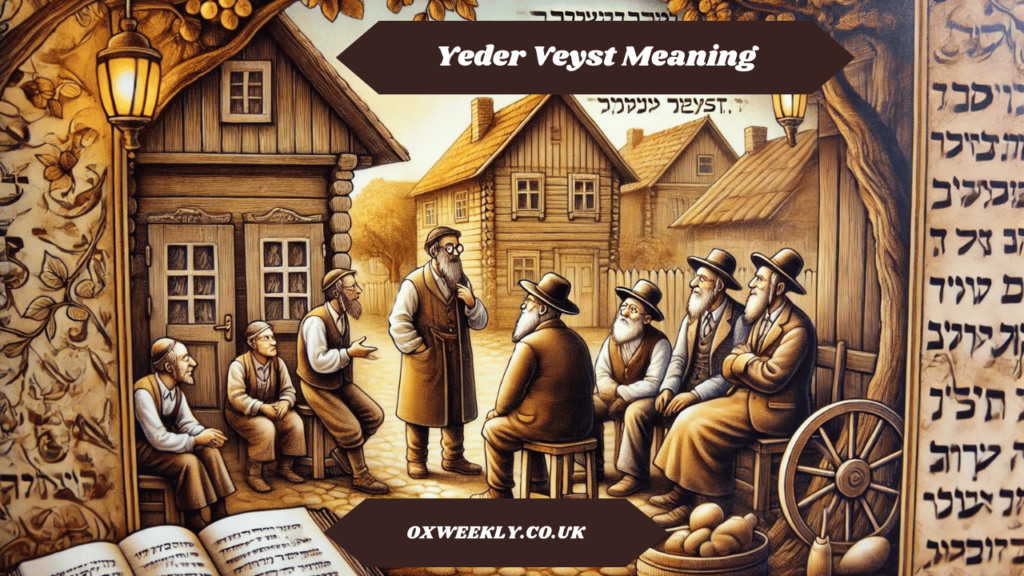Introduction: The Depth Behind “Yeder Veyst”

The Yiddish language, rich in history and cultural richness, has numerous idioms that have lasted the test of time. One such term is “Yeder Veyst.” While seemingly simple, its significance and consequences go deep. In this article, we will study the roots, importance, and usage of “Yeder Veyst” to understand its position in Yiddish-speaking communities and beyond.
The Literal Meaning of “Yeder Veyst”
The word “Yeder Veyst” translates literally to “Everyone knows” in English. It is typically used to signify that a fact or piece of information is general knowledge. However, like many Yiddish idioms, it conveys more than simply a literal meaning—it is filled with cultural significance, tone, and occasionally, even sarcasm.
The Historical Roots of “Yeder Veyst”
Yiddish developed as a language among Ashkenazi Jews in Central and Eastern Europe, borrowing elements from German, Hebrew, and Slavic languages. The phrase “Yeder Veyst” has been used for generations, reflecting a sense of shared understanding within Jewish communities. It is often used in conversations to reinforce collective knowledge, whether referring to everyday matters, communal beliefs, or even inside jokes.
Cultural and Social Implications of “Yeder Veyst”

In Yiddish-speaking communities, communication is often enriched with expressive phrases that go beyond direct translation. “Yeder Veyst” can carry different connotations depending on the context and tone in which it is spoken:
- Affirmation of Shared Knowledge: It can be used to underline that a specific truth is generally accepted or globally recognized.
- Hint of Sarcasm or Exaggeration: In certain circumstances, it can be used to indicate that something is purportedly common knowledge, even if it may not be generally understood.
- Expression of Frustration: It can also serve as a technique to convey that something should be evident, typically used in debates or conversations to underline a point.
Modern Usage of “Yeder Veyst” in Yiddish and Beyond
While Yiddish is no longer as widely used as it once was, its impact remains significant, especially in Jewish communities across the world. “Yeder Veyst” is still regularly used in Yiddish-speaking families, literature, and even comic circumstances. The term has also acquired a place in popular culture, notably in humor and narrative, where it helps to link viewers with a sense of common understanding.
The Emotional Nuance Behind “Yeder Veyst”
One of the most remarkable elements of Yiddish idioms is their capacity to communicate emotion beyond simple words. “Yeder Veyst” can show companionship, laughter, or even annoyance. The tone of voice, facial expressions, and context all add to the meaning behind the statement, making it a dynamic aspect of Yiddish communication.
Comparison to Similar Expressions in Other Languages
Every language has its own way of conveying shared knowledge or common understanding. Some comparable phrases include:
- English: “Everybody knows” or “It’s common knowledge.”
- German: “Jeder weiß das.”
- Hebrew: “Kol echad yodea” (כל אחד יודע), which has a similar meaning.
- Russian: “Все знают” (Vse znayut), meaning “everyone knows.”
While these phrases serve similar purposes, the Yiddish “Yeder Veyst” often carries an additional layer of cultural warmth, humor, or irony that is hard to replicate in direct translation.
The Role of “Yeder Veyst” in Jewish Humor and Storytelling

Yiddish is noted for its expressive, frequently funny character, and “Yeder Veyst” plays a vital part in narrative and comedy. It can be used to build up a joke, emphasize an odd circumstance, or exaggerate an evident reality for humorous effect. Many Jewish comedians and authors have included this term into their work, keeping its spirit alive in current entertainment.
The Importance of Preserving Yiddish Expressions
With the decline in native Yiddish speakers, phrases like “Yeder Veyst” hold historical and cultural significance. Efforts to preserve Yiddish literature, music, and theater have helped keep such expressions alive. Understanding and using phrases like “Yeder Veyst” contributes to the appreciation and preservation of Yiddish heritage.
Conclusion: Why “Yeder Veyst” Matters
“Yeder Veyst” is more than just a phrase—it is a representation of shared knowledge, cultural richness, and emotional depth within Yiddish-speaking communities. Whether used to reinforce a known fact, add comedy to a discourse, or highlight an evident truth, this term remains a treasured component of Yiddish communication. By analyzing its meaning and ramifications, we get insight into the richness of Yiddish and its continuing effect on language and society.
As languages evolve, it is essential to remember and celebrate the expressions that have shaped generations. “Yeder Veyst” is one such phrase that continues to resonate, reminding us of the power of shared understanding and the beauty of linguistic heritage.

































